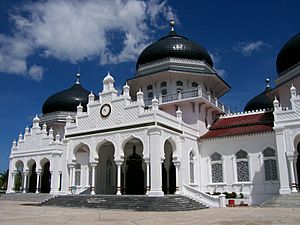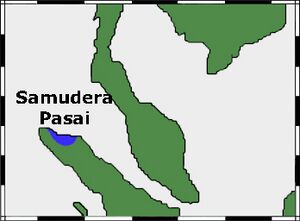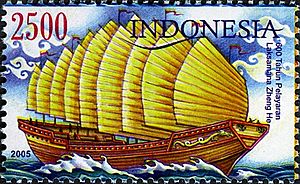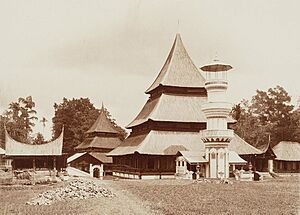Spread of Islam in Indonesia facts for kids
The story of how Islam arrived in Indonesia is not fully clear. One idea is that Islam came directly from Arabia as early as the 800s. This was during the time of the Umayyad and Abbasid rulers. Another idea suggests that Sufi travelers brought Islam in the 1100s or 1200s. They might have come from Gujarat in India or from Persia. Before Islam, the main religions in Indonesia were Hinduism and Buddhism.
For many centuries, the islands of Indonesia were known for spices like nutmeg and cloves. These were very important in the spice trade long before the Portuguese arrived in 1511. Indonesia's location was key, acting as a bridge between the Muslim world and Imperial China. This made it a busy place for merchants from many different cultures. It became a place where people shared their ways of life, including the Islamic faith.
Even though Islam's arrival was a huge event in Indonesian history, there isn't much clear evidence about it. Scholars still debate how people in Indonesia became Muslim. The main clues are old gravestones and stories from travelers. These only show that Muslims were in certain places at certain times. They don't fully explain how the new religion changed daily life or how deeply it affected societies. For example, just because a ruler became Muslim, it doesn't mean everyone in that area did too. However, a big change happened when the Hindu Majapahit empire in Java was taken over by the Muslim Demak Sultanate. In 1527, the Muslim ruler renamed Sunda Kelapa to Jayakarta, meaning "precious victory." This name later became Jakarta.
The spread of Islam was slow at first. The evidence we have suggests it sped up in the 1400s. One special thing about its spread was that it happened mostly peacefully. Muslim traders settled in coastal areas and mixed with the local people. Soon, new Muslim communities grew. Travelers like Ibn Battuta, Zheng He, and Marco Polo wrote about these communities. Many Muslims married into royal families. Their children then started various sultanates (kingdoms ruled by a sultan) in Sumatra and Java.
Important kingdoms included Mataram in Central Java, and the sultanates of Ternate and Tidore in the Maluku Islands. By the late 1200s, Islam was in North Sumatra. By the 1300s, it reached northeast Malaya, Brunei, the southern Philippines, and some royal courts in East Java. By the 1400s, it was in Malacca and other parts of the Malay Peninsula. Islam started in the west of Indonesia. However, the scattered evidence shows it wasn't a quick wave of conversion. Instead, it was a complex and slow process.
Contents
Early Muslim Presence in Indonesia
Before Islam became common in Indonesian communities, Muslim traders had been there for hundreds of years. Historians say that Islam spread in Indonesia in two ways. First, Indonesians met Muslims and converted. Second, foreign Muslims from Asia (like Indians, Chinese, and Arabs) settled in Indonesia and mixed with local people. Islam is thought to have been in Southeast Asia since the early days of Islam. How and why the first Indonesians became Muslim is still debated because there are not many old written records.
The earliest stories about Indonesia come from the Abbasid Caliphate. These old stories say that Muslim sailors knew Indonesia well. This was mainly because of its many valuable spices like nutmeg, cloves, and galangal.
However, just because foreign Muslims were in Indonesia doesn't mean many local people converted or that Islamic states were formed early on. The best evidence for Islam's early spread comes from gravestones and a few traveler stories. The oldest clear gravestone is from 1082 AD. But it belonged to a non-Indonesian Muslim, so it might have been brought to Java later. The first proof of Indonesian Muslims comes from northern Sumatra. Marco Polo, returning from China in 1292, wrote about at least one Muslim town. The first sign of a Muslim ruling family is a gravestone from 1297 AD. It belongs to Sultan Malik al Saleh, the first Muslim ruler of the Samudera Pasai Sultanate. Other gravestones show that Islamic rule continued there. In 1346, Ibn Battuta, a traveler from Morocco, reported that the ruler of Samudera Pasai was a very religious Muslim. He followed the Shafi'i school of Islamic law, which later became common in Indonesia.
Zheng He's Voyages and Chinese Muslims
Zheng He is believed to have helped Chinese Muslim communities settle in Palembang and along the coasts of Java, the Malay Peninsula, and the Philippines. These Muslims followed the Hanafi school of thought and spoke Chinese. A leader named Hajji Yan Ying Yu encouraged these Chinese Muslims to blend in and take local names.
Zheng He (1371–1433 or 1435) was a Chinese explorer and admiral during China's early Ming dynasty. He led huge voyages to Southeast Asia, South Asia, Western Asia, and East Africa from 1405 to 1433. His ships were enormous, much bigger than Christopher Columbus's ships. They carried hundreds of sailors on many decks. Zheng He was a favorite of the Yongle Emperor and became a top official. His voyages were not well-known in Chinese history for a long time. But they became famous after a book about him was published in 1904. A special stone with writing in three languages, left by Zheng He, was found in Sri Lanka soon after.
Islam's Spread by Region
It was once thought that Islam spread mostly peacefully in Indonesia. Many scholars still believe this. From the 1300s to the late 1800s, there was almost no organized Muslim missionary work. Later discoveries by scholars show that some parts of Java, like Sundanese West Java and the Majapahit kingdom in East Java, were conquered by Javanese Muslims. The Hindu-Buddhist Sunda Kingdom of Pajajaran was taken over by Muslims in the 1500s. Also, the Muslim coastal areas and Hindu-Buddhist inland areas of East Java often fought. The organized spread of Islam is also clear from the Wali Sanga (nine holy leaders). They are credited with spreading Islam in Indonesia during this time.
Northern Sumatra's Conversion
More solid evidence of cultural changes comes from two gravestones from the late 1300s in Minye Tujoh, North Sumatra. Both have Islamic writings, but one uses Indian-style letters and the other Arabic. Gravestones from the 1300s in Brunei, Terengganu (northeast Malaysia), and East Java also show Islam's spread. The Trengganu stone has more Sanskrit words than Arabic, suggesting the introduction of Islamic law. According to a book from 1433 by Ma Huan, a writer for Zheng He, the main states in northern Sumatra were already Islamic Sultanates. In 1414, he visited the Malacca Sultanate. Its ruler, Iskandar Shah, was Muslim, and so were his people. They were very strict in their faith.
In Kampong Pande, the gravestone of Sultan Firman Syah says that Banda Aceh was the capital of the Kingdom of Aceh Darussalam. It also says it was built on April 22, 1205, by Sultan Johan Syah after he defeated the Hindu and Buddhist Kingdom of Indra Purba. More Islamic states were formed in North Sumatra. This is shown by graves from the late 1400s and 1500s. These include the graves of the first and second Sultans of Pedir. Aceh was founded in the early 1500s and became the most powerful state in North Sumatra and the Malay archipelago. The first sultan of the Aceh Empire was Ali Mughayat Syah.
The book by Portuguese writer Tomé Pires is an important source on Islam's spread in Indonesia. He wrote about his visits to Java and Sumatra from 1512 to 1515. In 1520, Ali Mughayat Syah began military campaigns to control northern Sumatra. He conquered Daya and made its people convert to Islam. He also took over pepper and gold-producing areas along the east coast. This led to some problems within the Sultanate. Aceh was a trading port, and its economic goals were different from those of the producing regions.
At this time, Pires wrote that most Sumatran kings were Muslim. From Aceh south along the east coast to Palembang, the rulers were Muslim. South of Palembang and along the west coast, most rulers were not. In other Sumatran kingdoms, like Pasai and Minangkabau, the rulers were Muslim. Their people and those in nearby areas were not yet Muslim, but the religion was gaining new followers.
After the Portuguese arrived and caused tensions over the spice trade, the Acehnese Sultan Alauddin al-Kahar (1539–71) asked the Ottoman Sultan Suleiman the Magnificent for help in 1564. The Ottomans sent their admiral Kurtoğlu Hızır Reis with 22 ships carrying soldiers and supplies. According to Portuguese Admiral Fernão Mendes Pinto, the Ottoman fleet that reached Aceh included some Turks and many Muslims from Indian Ocean ports.
East Sumatra and Malay Peninsula
The Malacca Sultanate was a major Malay trading state. It was founded around the early 1400s by Sultan Parameswara. As the most important trading center in Southeast Asia, it became a hub for foreign Muslims and helped spread Islam. Parameswara himself converted to Islam and took the name Iskandar Shah after the Chinese Admiral Zheng He arrived. Gravestones from Malacca and other places show that Islam spread across the Malay archipelago. They also show it became the religion of many cultures and their rulers in the late 1400s.
Central and Eastern Java
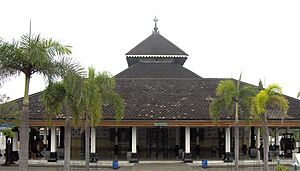
Gravestones from 1369 in East Java have writings in Old Javanese instead of Arabic. This suggests they belonged to Javanese Muslims, not foreigners. Their fancy decorations and closeness to the old Hindu-Buddhist Majapahit capital mean they were likely graves of important Javanese, maybe even royalty. This shows that some Javanese leaders adopted Islam when the Hindu-Buddhist Majapahit was still very strong.
Historians like Ricklefs (1991) say these East Javan gravestones, found inland at Majapahit, challenge the old idea that Islam in Java started on the coast. The old idea was that Islam was a political and religious challenge to the kingdom. Majapahit had wide trade contacts, so it must have met Muslim traders. However, it's debated if its sophisticated royal court would be interested in a merchant's religion. Instead, mystical Sufi Muslim teachers, who might have claimed special powers, are thought to have been more likely to convert Javanese elites. These elites were already familiar with Hindu and Buddhist mysticism.
Central and East Java, where the Javanese people lived, were still ruled by the Hindu-Buddhist king in Daha. But coastal areas like Surabaya became Muslim and often fought with the inland kingdom. Some of these coastal Muslim leaders were Javanese who had converted. Others were Muslim traders from China, India, Arabia, and Malaya who had settled and built trading states on the coast. This conflict between the Muslim coast and Hindu-Buddhist inland continued long after the Majapahit empire fell to the Demak Sultanate. The bad feelings also lasted long after both regions became Muslim.
It's not clear when the people on Java's north coast became Muslim. Chinese Muslim Ma Huan, who traveled with Zheng He, visited Java in 1416. He wrote in his 1433 book that there were only three kinds of people in Java: Muslims from the west, Chinese (some Muslim), and the non-Muslim Javanese. Since the East Javan gravestones were for Javanese Muslims fifty years earlier, Ma Huan's report suggests that Javanese nobles might have adopted Islam before the coastal Javanese.
An early Muslim gravestone from 1419 AD was found at Gresik, an East Javanese port. It marks the burial of Malik Ibrahim. However, since he seems to have been a foreigner, the gravestone doesn't prove that coastal Javanese converted. But Javanese stories say Malik Ibrahim was one of the first nine important Islamic teachers in Java, known as the Wali Sanga. There's no written proof for this tradition. In the late 1400s, the powerful Majapahit empire in Java was weakening. After losing several battles, the last Hindu kingdom in Java fell to the rising power of the Muslim Demak Sultanate in 1520.
The Walisongo's Peaceful Spread of Islam
Why did Islam spread so quickly in Java in just 40–50 years, after being slow to grow before? A key reason for the success of the Walisongo (nine holy leaders) was how they built a new civilization from the old Majapahit one, but with Islamic values. For example, until the early Demak era, society was divided into two main groups, just like in the Majapahit era. First, the Gusti group, who lived in the palace. Second, the Kawula group, who lived outside the palace.
Gusti meant "master," and Kawula meant "slaves" or "servants." Kawula only had the right to lease land, not own it. Ownership belonged only to the Gusti. In the Majapahit era, all property belonged to the palace (the kingdom). If the king wanted to reward someone, that person would be given "sima land" or "perdikan land" (a type of fief). This meant if a Kawula received land, their social status would rise, and they would become a Gusti, gaining ownership rights.
The Walisongo, especially Sheikh Siti Jenar and Sunan Kalijaga, brought new ideas about society. They changed the "Gusti and Kawula" structure. They introduced the idea of "Masyarakat," which comes from the Arabic word "Musharaka." This means a community of equal people who cooperate. The words "masyarakat" and "rakyat" (people) were new terms brought by the Walisongo.
One method the Walisongo used was changing how people thought about themselves. Gusti used to call themselves "intahulun," "kulun," or "ingsun." Kawula called themselves "kula" or "kawula" (Javanese), "abdi" (Sundanese), "saya" or "sahaya" (Sumatran), and "hamba" or "ambo" (Minangkabau). These words meant "slaves" or "servants." The Walisongo changed these terms to "ingsun," "aku," "kulun," or "awak," and other words that did not show a slave identity or lower social status. This was the Walisongo's idea of "Masyarakat"—a community of equal people who cooperate, without discrimination between classes like "Gusti and Kawula." Today, words like "kula," "ambo," "abdi," "hamba," and "saya" are still used to show respect to older people, parents, or strangers.
In the Majapahit era, besides the Gusti class, people did not own property like houses or cattle. Everything belonged to the palace. By changing the social structure, the idea of subject classes was removed because of the new system's equality.
The Walisongo saw that Hinduism and Buddhism were mainly followed by the Gusti in the palaces. The common people outside the palace followed Kapitayan. This religion worshipped a deity called Sang Hyang Taya. Taya means "empty" or "nothing." The God in Kapitayan was abstract and could not be described directly. Sang Hyang Taya was simply "tan keno kinaya ngapa," meaning "cannot be seen, thought, or imagined." The power of Sang Hyang Taya was seen in places like stones, monuments, and trees. Offerings were given at these places, not to worship the objects themselves, but to show devotion to Sang Hyang Taya, whose power was present there. This idea is similar to the concept of Brahman in Hinduism.
Kapitayan was an ancient religion. Its old remains, like dormant stones, menhirs, and sarcophagus, show its presence. Dutch historians called this religion animism and dynamism because it seemed to worship trees, rocks, and spirits. However, Ma Huan called such practices "nonbeliever."
The Walisongo adopted these Kapitayan values to spread Islam. The concept of "tawhid" (oneness of God) in Kapitayan was similar to Islam's. "Tan keno kinaya ngapa" in Kapitayan ("cannot be seen, thought, or imagined, He is beyond everything") has a similar meaning to "laisa kamitslihi syai'un" in Islam ("There is nothing like unto Him"; Qur'an 42:11).
The Walisongo also used the term "Sembahyang" (worshipping Sang Hyang Taya in Kapitayan) to introduce "Shalat" (prayer) in Islam. For places of worship, they used the Kapitayan term "Sanggar." This was a four-sided building with an empty hole, symbolizing Sang Hyang Taya, not statues like in Hindu or Buddhism. The Walisongo used this term for places of prayer, calling them "Langgar," which is similar to a Masjid (mosque) in Islam.
There was also a Kapitayan ritual of not eating from morning until night, called Upawasa (Puasa or Poso). Fasting in Hinduism is also called "Upawasa." Instead of using the Islamic term "Siyam" for fasting, the Walisongo used "Puasa" or "Upawasa" from Kapitayan. The Kapitayan tradition of "Poso Dino Pitu" (fasting on the second and fifth days, totaling seven days) is very similar to Islamic fasting on Mondays and Thursdays. The Kapitayan tradition of "Tumpengan" (a cone-shaped rice dish for ceremonies) was also kept by the Walisongo under an Islamic view, known as "Sedekah" (charity). This is what Gus Dur (Indonesia's fourth president) called "mempribumikan Islam" (making Islam local).
During the Majapahit era, there was a ceremony called "Sraddha," held 12 years after a person's death. A poet named Mpu Tanakung wrote a poem describing this ceremony as very grand. This tradition was later called Sadran or Nyadran by people near lakes and beaches. The Walisongo, who came from Champa, also brought religious traditions like ceremonies for 3, 7, 40, 100, and 1000 days after someone's death. These traditions came from Champa, not from native Javanese or Hindu customs. They also exist in parts of Central Asia, like Uzbekistan and Kazakhstan.
The Walisongo spread Islam without using force or spilling blood. It was only after the Dutch period, especially after the Diponegoro War, that the Dutch faced financial problems. They even owed millions of Guldens. Even after Prince Diponegoro was captured, his followers remained strong. The Dutch then changed stories about the Walisongo, as seen in the Babad Kediri. From this, books like Darmo Gandul and Suluk Gatholoco appeared. The author, Ngabdullah, from Pati, East Java, left Islam due to poverty. He later changed his name to Ki Tunggul Wulung and settled in Kediri.
These stories often contradict historical facts. For example, they say the Demak attacked Majapahit in 1478. They also feature a fictional character, Sabdo Palon Naya Genggong, who swore that Majapahit would rise again 500 years after the attack. However, more reliable old texts say that King Girindrawardhana, the Hindu king of Kediri, attacked Majapahit that year. Because of the strong influence of this tale, President Soeharto, Indonesia's second president, was very confident. He passed a law for "Aliran Kepercayaan" (Beliefs) in Indonesia in 1978 (500 years after 1478). This was a symbol of Sabdo Palon's oath about Majapahit's return.
The Dutch secretly wrote their own history to confuse the struggle of Muslims, especially Prince Diponegoro's followers. The Dutch even made their own version of Babad Tanah Jawi, different from the original. For example, the text of the Kidung Sunda describes the Bubad War. It says Gajah Mada killed the King of Sunda and his family. This made the Sundanese people hold a grudge against the Javanese. But this text only appeared in Bali in 1860, ordered by the Dutch. Sunda was a great kingdom. If such an event truly happened, the Kingdom of Sunda would have written about it. The Kingdom of Sunda recorded its history in great detail. Even Sundanese traditions were written in the "Sanghyang Siksa Kanda ng Karesyan" manuscript. How could such a big event never be mentioned in the Chronicle of Sunda (Babad Sunda)? It was also never mentioned in the Chronicles of Majapahit or any other historical records. This was a Dutch tactic to divide society by creating false history, part of their "Divide and Conquer" policy. All these historical distortions likely came from texts written by the Dutch after the Diponegoro War.
In metalworking, the people of Majapahit could already make famous items like keris (daggers), spears, and arrows. They even made "barunastra," giant steel arrows that worked like underwater torpedoes. When fired, they could pierce and sink ships. The Demak Sultanate, as Majapahit's successor, could make large cannons. These were exported to Malacca, Pasai, and even Japan. The Portuguese recorded that the Japanese bought guns from Demak. When the Portuguese conquered the Port of Malacca, their spies learned that the Malacca fortress had large cannons imported from Java. When the Portuguese first arrived from Europe, their ships were damaged by cannon fire when approaching Malacca. Proof of this can be seen in Fort Surosowan Banten. In front of it, there is a giant cannon named "Ki Amok." It's so big that people can get inside its barrel. The imperial seal of the Demak Kingdom is still clearly on the cannon. It was made in Jepara, a region in Demak famous for its crafts. The terms "bedil besar" ("big guns") and "jurumudi ning bedil besar" ("the driver of the big guns") described cannons and cannon operators. This was the military technology during the Walisongo era.
The famous puppet show in Majapahit was "Wayang Beber." During the Walisongo era, it became "Wayang Kulit" (shadow puppets). The Walisongo also changed the story of Mahabharata from the original version in India. In the Indian version, the Five Pandavas share one wife, Draupadi, which is polyandry. The Walisongo changed this. They said Draupadi was the wife of Yudhishthira, the eldest brother. Werkudara or Bima had a wife named Arimbi, and later married Dewi Nagagini, with whom he had children Ontorejo and Ontoseno. This showed that all the Pandavas practiced polygamy. In the original version, Draupadi was polyandrous with the five Pandavas. Similarly, in the story of Ramayana, Hanuman had two fathers: King Kesari Maliawan and God Bayu. The Walisongo said Hanuman was the son of God Bayu. The Walisongo even created a family tree that showed the gods were descendants of Adam. This can be seen in the Pakem Pewayangan (puppet show guide) Ringgit Purwa at Pustaka Raja Purwa in Solo. This guide is used by all puppet masters in Java. So, the puppet show guide used by Javanese puppeteers came from the Walisongo, not India. These puppet shows were not just entertainment. They also helped the Walisongo spread Islam.
In literature, the kingdom of Majapahit had already created Kakawin and Kidung (types of poems). The Walisongo added to this literary richness by creating various song compositions. These included "Tembang Gedhe" (great song), "Tembang Tengahan" (mid song), and "Tembang Alit" (short song). Macapat (a type of Javanese poetry) became popular in coastal areas. Kakawin and Kidung could only be understood by poets. But Tembang could be understood even by people who couldn't read or write. This was how the Walisongo spread Islam through arts and culture.
Another example of the Walisongo's work is Slametan, developed by Sunan Bonang and followed by other Sunans. In the Tantrayana (Tantric) religion, which was followed by kings in the Nusantara archipelago, there was a sect called Bhairawa Tantra. This sect worshipped the Goddess of Earth, Goddess Durga, Goddess Kali, and other Gods. They had rituals where they created a circle called Ksetra. The largest Ksetra in Majapahit was Ksetralaya, which is now called Troloyo.
At the Indonesian National Museum in Jakarta, there is a three-meter-tall statue of a person named Adityawarman standing on a pile of skulls. He was a priest of the Bhairawa Tantra. He taught the "malima" practice. He was made a Bhairawa priest with the title Wisesa Dharani, meaning "ruler of the earth."
Seeing this, Sunan Bonang created a similar event. He went to the center of Bhairawa Tantra in Kediri. Kediri was once the center of Bhairawa Tantra, which is why its slogan today is Canda Bhirawa. During his work in Kediri, Sunan Bonang stayed west of the river, in Singkal village, Nganjuk. There, he held a similar ceremony. He made a similar circle, but all the participants were men. In the center of the circle, there was food, and then they prayed together. This is called the Kenduri Tradition (festivity tradition) or Slametan. It spread from village to village to match the malima ceremony (Panchamakara). Because of this, Sunan Bonang was also known as Sunan Wadat Cakrawati, the leader or imam of Chakra Iswara (Cakreswara).
So, in rural areas, people were considered Muslim if they said the Islamic creed, were circumcised, and participated in Slametan. Islam then grew even faster because people preferred to join Slametan for "slamet" (safety).
In summary, Islam was in Indonesia for about 800 years, from 674 to the Walisongo era in 1470. But it wasn't widely accepted by society until after the Walisongo era. Then, Islam spread very widely across the archipelago. Even today, the teachings of the Walisongo are still followed by most Indonesian Muslims.
Western Java's Conversion
Pires' book Suma Oriental says that Sundanese-speaking West Java was not Muslim in his time and was even against Islam. Muslims conquered this area later in the 1500s. In the early 1500s, Central and East Java (home of the Javanese) were still ruled by the Hindu-Buddhist king in Daha (Kediri). However, the north coast was Muslim as far as Surabaya and often fought with the inland kingdom. Some of these coastal Muslim leaders were Javanese who had converted to Islam. Others were not originally Javanese but were Muslim traders who settled along trade routes. These included Chinese, Indians, Arabs, and Malays. According to Pires, these settlers admired Javanese Hindu-Buddhist culture so much that they copied its style and became Javanese themselves.
In his study of the Banten Sultanate, Martin van Bruinessen looked at the connection between mystics and royalty. He noted that the spread of Islam there was different from other parts of Java. He said that in Banten, local sources link the tarekats (Sufi orders) not to trade, but to kings, magical power, and political legitimacy. He showed evidence that Sunan Gunungjati was part of the Kubra and Shattari Sufi orders.
Other Areas of Islam's Spread
There is no evidence that Indonesians outside of Java, Sumatra, the sultanates of Ternate and Tidore in Maluku, and Brunei and the Malay Peninsula adopted Islam before the 1500s.
Indonesian and Malay Legends
While we can generally figure out when Islam was established in different Indonesian regions, old historical sources don't answer many specific questions. There's a lot of debate about these topics. These sources don't explain why many Indonesians didn't convert to Islam until centuries after foreign Muslims visited and lived in Indonesia. They also don't fully explain how Indonesia's unique types of Islam started and grew, or how Islam became the main religion. To fill these gaps, many scholars look at Malay and Indonesian legends about how Indonesians converted to Islam. Historian Ricklefs says that even though these legends aren't exact historical records, they are valuable. They show how people learned, the magical powers involved, the foreign origins and trade connections of early teachers, and how conversion moved from leaders downwards. These stories also show how later generations of Indonesians viewed the spread of Islam. These sources include:
- Hikayat Raja-raja Pasai ("The Story of the kings of Pasai") – an Old Malay text that tells how Islam came to "Samudra" (Pasai, northern Sumatra), where the first Indonesian Islamic state was founded.
- Sejarah Melayu ("Malay History") – an Old Malay text, which like Hikayat Raja-raja Pasai tells the story of the conversion of Samudra, but also tells of the conversion of the King of Malacca.
- Babad Tanah Jawi ("History of the land of Java") – a general name for many old writings. They say the first Javanese conversions were thanks to the Wali Sanga ("nine saints").
- Sejarah Banten ("History of Banten") – a Javanese text with stories of conversion.
Of these texts, the Malay ones describe conversion as a big turning point. It was marked by clear signs like circumcision, saying the Confession of Faith, and taking an Arabic name. On the other hand, while magical events are still important in the Javanese stories of Islam's spread, such clear turning points are not as obvious. This suggests a more gradual process for the Javanese. This fits with the much larger mix of old beliefs (syncretic element) in today's Javanese Islam, compared to the more traditional Islam in Sumatra and Malaysia.
Flags of the Sultanates in the East Indies (Indonesia)
See also
- Islam in Indonesia
- History of Indonesia
- Mosques in Indonesia
- Spread of Islam in Southeast Asia
- Spread of Islam


